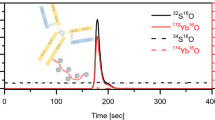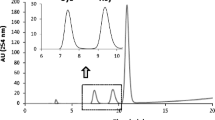Abstract
Microbore affinity-HPLC (AF-HPLC) hyphenated to inductively coupled plasma-sector field mass spectrometry (ICP-SFMS) was applied to the simultaneous speciation analysis of glutathione peroxidase (GPx), selenoprotein P (SelP) and seleno-albumin (SeAlb) in 5 μL of (human) serum. ICP-SFMS (high resolution mode, HR, M/ΔM = 10,000) was used for the quantification of selenium in GPx, SelP and SeAlb after their separation by AF-HPLC, without prior sample preparation or mathematical correction of the spectral interferences. In order to compensate for the loss in sensitivity due to the detection in HR mode and the very low amount of sample taken for analysis, a high-efficiency sample introduction system was used as an interface between AF-HPLC and ICP-SFMS. This led to a signal-to-noise ratio enhancement of about one order of magnitude compared to the conventional experimental ICP-SFMS set-up. Apart from the very low sample consumption, another major advantage of the method described here is the significant reduction of the analysis time (≤7 min). Quantification of GPx, SelP and SeAlb was carried out using on-line (post column) isotope dilution; comparison with on-line external calibration by using Se-L-cystine standard is also addressed. The method accuracy for the determination of total protein bound Se was assessed by the analysis of a human serum reference material (BCR-637) certified for total Se content.



Similar content being viewed by others
References
Raich PC, LuJ THJ, Combs GF (2001) Selenium in cancer prevention: clinical issues and implications. Cancer Investig 19:540
Hatfield DL, Berry MJ, Gladyshev VN (2006) Selenium: Its molecular biology and role in human health. Springer, New York
Papp LV, Lu J, Holmgren A, Khanna KK (2007) From selenium to selenoproteins: synthesis, identity, and their role in human health. Antioxid Redox Signal 9:775
Wang W, Chen Z, Davey DE, Naidu R (2009) Extraction of selenium species in pharmaceutical tablets using enzymatic and chemical methods. Microchim Acta 165(1–2):167
Deng B, Shi A, Li L, Xie F, Lu H, Xu Q (2009) Determination of selenomethionine in selenium-enriched yeast using capillary electrophoresis on-line coupled with electrochemiluminescence detection. Microchim Acta 165(3–4):279–283
Hinojosa Reyes L, Marchante-Gayon JM, Garcia Alonso JI, Sanz-Medel A (2003) Quantitative speciation of selenium in human serum by affinity chromatography coupled to post-column isotope dilution analysis ICP-MS. J Anal At Spectrom 18:1210
Jitaru P, Prete M, Cozzi G, Turetta C, Cairns W, Seraglia R, Traldi P, Cescon P, Barbante C (2008) Speciation analysis of selenoproteins in human serum by solid-phase extraction and affinity HPLC hyphenated to ICP-quadrupole MS. J Anal At Spectrom 23:402
Shigeta K, Sato K, Furuta N (2007) Determination of selenoprotein P in submicrolitre samples of human plasma using micro-affinity chromatography coupled with low flow ICP-MS. J Anal At Spectrom 22:911
Jitaru P, Cozzi G, Gambaro A, Cescon P, Barbante C (2008) Simultaneous speciation analysis of glutathione peroxidase, selenoprotein P and selenoalbumin in human serum by tandem anion exchange-affinity HPLC and on-line isotope dilution ICP-quadrupole MS. Anal Bioanal Chem 391:661
Xu M, Yang L, Wang Q (2008) Quantification of selenium-tagged proteins in human plasma using species-unspecific isotope dilution ICP-DRC-qMS coupled on-line with anion exchange chromatography. J Anal At Spectrom 23:1545
Suzuki KT, Ogra Y (2002) Metabolic pathway for selenium in the body: speciation by HPLC-ICP MS with enriched Se. Food Addit Contam 19:974
Palacios O, Lobinski R (2007) Investigation of the stability of selenoproteins during storage of human serum by size-exclusion LC-ICP-MS. Talanta 71:1813
Shigeta K, Matsumura K, Suzuki Y, Shinohara A, Furuta N (2008) Distribution and dynamic pathway of selenium species in selenium-deficient mice injected with 82Se-enriched selenite. Anal Sci 24:1117
Palacios O, Ruiz Encinar J, Schaumloffel D, Lobinski R (2006) Fractionation of selenium-containing proteins in serum by multiaffinity liquid chromatography before size-exclusion chromatography-ICPMS. Anal Bioanal Chem 384:1276
Ruiz Encinar J, Schaumloffel D, Ogra Y, Lobinski R (2004) Determination of selenomethionine and selenocysteine in human serum using speciated isotope dilution-capillary HPLC-inductively coupled plasma collision cell mass spectrometry. Anal Chem 76:6635
Rodriguez-Castrillon JA, Hinojosa Reyes L, Marchante-Gayon JM, Moldovan M, Garcia Alonso JI (2008) Internal correction of spectral interferences and mass bias in ICP-MS using isotope pattern deconvolution: application to the determination of selenium in biological samples by isotope dilution analysis. J Anal At Spectrom 23:579
Schaumloffel D, Bierla K, Lobinski R (2007) Accurate determination of selenium in blood serum by isotope dilution analysis using inductively coupled plasma collision cell mass spectrometry with xenon as collision gas. J Anal At. Spectrom 22:318
Pozebon D, Dressler VL, Becker JS, Matusch A, Zoriyd M, Becker JS (2008) Biomonitoring of essential and toxic elements in small biological tissues by ICP-MS. J Anal At Spectrom 23:1281
Affinity Chromatography. Principles and Methods, Amersham Biosciences, http://www4.gelifesciences.com/aptrix/upp01077.nsf/Content/orderonline_handbooks
Warburton E, Goenaga-Infante H (2007) Methane mixed plasma-improved sensitivity of inductively coupled plasma mass spectrometry detection for selenium speciation analysis of wheat-based food. J Anal At Spectrom 22:370
Rodriguez-Gonzalez P, Marchante-Gayon JM, Garcia Alonso JI, Sanz-Medel A (2005) Isotope dilution analysis for elemental speciation: a tutorial review. Spectrochim Acta Part B 60:151
International Conference on Harmonization (ICH) of Technical Requirements for the Registration of Pharmaceuticals for Human Use, ICH Harmonised Tripartite Guideline, Validation of analytical procedures: Text and Methodology, ICH-Q2(R1). Current Step 4 version (2005), Geneva
Acknowledgements
This study is a contribution to the Marie-Curie Intra-European Project (MEIF-CT-2006-024156/ELSA-BIM) funded by the European Commission and to the iMERA-Plus project (TRACEBIOACTIVITY) funded by the European Metrology Research Programme (EMRP). The authors thank Drs. Warren Cairns and Clara Turetta (IDPA-CNR) for the scientific discussions. ELGA LabWater is acknowledged for providing the PURELAB Option-R and Ultra Analytic systems, which produced the ultra-pure water used in these experiments.
Author information
Authors and Affiliations
Corresponding author
Rights and permissions
About this article
Cite this article
Jitaru, P., Roman, M., Cozzi, G. et al. Speciation analysis of selenoproteins in human serum by microbore affinity-HPLC hyphenated to ICP-Sector field-MS using a high efficiency sample introduction system. Microchim Acta 166, 319–327 (2009). https://doi.org/10.1007/s00604-009-0208-5
Received:
Accepted:
Published:
Issue Date:
DOI: https://doi.org/10.1007/s00604-009-0208-5




